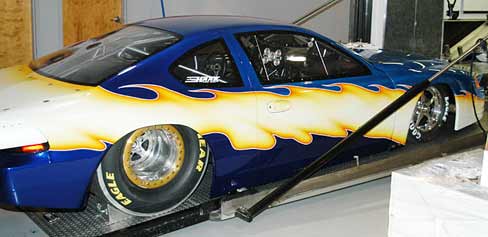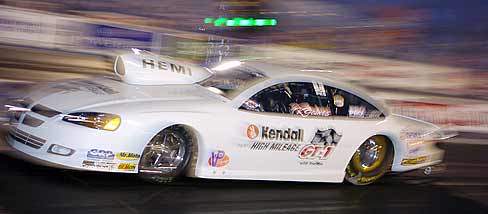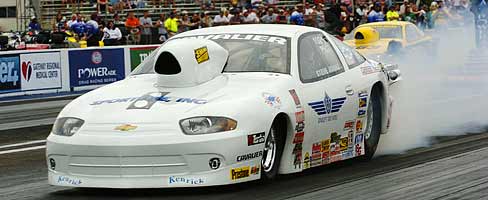Is the Future of Pro Stock in NASCAR Country?
By Dan Burkemper
7/9/04
![]() he gears of
the Pro Stock assembly line may be grinding to a halt. For years Pro Stock chassis
technology has been dominated by a handful of specialty manufacturers. Wizards
like Don Ness, Jerry Bickel, Jerry Haas and Rick Jones have long held the keys
to a successful run at factory hot rod glory.
he gears of
the Pro Stock assembly line may be grinding to a halt. For years Pro Stock chassis
technology has been dominated by a handful of specialty manufacturers. Wizards
like Don Ness, Jerry Bickel, Jerry Haas and Rick Jones have long held the keys
to a successful run at factory hot rod glory.
Now it seems racers may be looking for more when it comes to exploiting the limited creativity allowed by strict NHRA rules. A select few think they have what it takes to make the next big leap in chassis technology and they want to keep it all to themselves.
Renting, leasing and buying engines in Pro Stock used to be the norm. Now engines are widely being developed by in-house teams, and many think an in-house chassis program is the next logical step in Pro Stock evolution.
Greg Anderson and teammate Jason Line have made the Pro Stock world take notice. Anderson and Line have been directing their opponents to the trailer with devastating regularity and have left many scratching their heads.
"One of the reasons we have the advantage we have right now is that we have looked at other parts of the operation," Anderson said. "We have looked at every aspect of the car."
With only two years experience, Anderson said they are still a young team and cannot yet institute all of the changes they have in mind. "Build our own car in-house? Absolutely. I would love to do that," Anderson said. "That is absolutely what's going to happen in the near future."
Anderson said the possibilities that lie within creating new chassis technology are too strong to ignore.
"We've been running the same basic chassis for 20 years," Anderson said. " I don't know what they're going to end up looking like, or being like five years from now, but I know they are going to be different than they are now."

This new Jerry Haas-built car is now at Greg Anderson's
Mooresville, NC shop.
(Ian Tocher photo)
Anderson said car construction is no different than engine development. Either new developments need to be made or teams will just be the same or worse than competitors. Anderson said a better mousetrap needs to be built and those willing to break away and build it are going to be the most successful.
"There are only so many areas left that we feel we can find power in the engine. It gets more difficult every year and gains get smaller every year," Anderson said. "It's time to start looking around outside of the engine compartment and try to make things better with the car."
One team owner that has looked outside the engine compartment is Victor Cagnazzi. Cagnazzi and driver Stevie Johns (photo below) have been nipping at the heels of Anderson and Line. To get within biting distance, Cagnazzi has made some radical changes in the Pro Stock team approach.

Ron Lewis photo
One of the biggest changes came when Cagnazzi made Todd Bevis an offer he couldn't refuse. Bevis hung a big closed-sign on his chassis shop in Tyler, Texas and moved the whole family to Mooresville, N.C. to head an exclusive car building operation for Cagnazzi. Now, instead of catering to several clients, Bevis answers to only one.
With his sights set on climbing to the top of Pro Stock, Cagnazzi aimed high and built an 18,000-square-foot chassis shop in the heart of NASCAR country.
"The reason we are where we are, is that it's the heartbeat of racing and there are hundreds of talented fabricators that we can draw from," Cagnazzi said of the new shop location in the area of Charlotte Motor Speedway.
"The more we can learn about the way a car works, then we feel we can improve upon it," Cagnazzi said. "I think this has given us the opportunity to build better cars."
Cagnazzi said he began his in-house car-building program in July of 2003 and calls their current car, "eight cars in one," explaining that "It's been a giant evolution from the time it hit the track until the time it is sitting there right now."
Cagnazzi said inspiration was drawn from NASCAR teams and he has modeled his program after their formula. But he admits the efficiency and cost at which established builders can produce a car puts programs like his slightly out of reach for the average Pro Stock racer.
"What we're doing is not less expensive; it's more costly," Cagnazzi said.
Chassis builder Bevis said the program is running smoothly, but he feels the pressure that comes from being a one-man show. "In my opinion, the performance of the vehicle becomes more scrutinized," he admitted.
The ability to make quick changes to the car is one of the advantages that come from running a one-team car program. "If we want to change something, we just bring it in the shop and do it," Bevis explained. "And then if it's an advantage, no one else has it because it doesn't get outside of the people who are privy to the information."
Another advantage is the ability to stay focused on one car. This allows Bevis to concentrate on one problem without the distraction of dealing with several customer cars.
Bevis said he thinks this will continue as a trend in the class, but only if it produces results. "The whole industry is so performance oriented," Bevis said. "If it doesn't perform, then it won't continue."
Bevis said it all comes down to performance per dollar and believes the team may be able to extract more performance per dollar from the car than from the engine. He explained that sometimes the car is more advanced than the engine, and other times the engine is ahead of the car.
"Right now, our engine is ahead of the car," Bevis said.

Ron Lewis photo
Western Motorsports team owner and driver V. Gaines (above) has maintained his own chassis shop for nearly three years and thinks it may unlock some secrets to gaining an advantage in the class. Gaines hired a former Don Ness master fabricator to head his program.
"We're still learning," Gaines said. "The cars are always increasing in power and we try to stay up with that power."
Gaines said he thinks the basic chassis combination will not change and that the key will be to make what works, work better.
"There are different places to give it different rigidity or flexibility depending on what you are running," Gaines said. "The trick is to try to find that break-through adjustment that is going to make these cars leave harder and travel better."
Established builders such as Jerry Bickel and Jerry Haas think these programs will not provide enough return for the large investment required. Bickel said an in-house car building program works for NASCAR teams because of the number of cars built. Bickel does not see the same rules applying to the NHRA.
"These teams are going to build one or two cars per year. What are they going to do for the rest of the year?" Bickel asked. "They are going to have to start hiring work out and then they will be right back to where we are right now."
Bickel said he thinks teams need to concentrate on finding more power, rather than looking for advantages in the chassis.
"There's a lot more that can be developed in the engines, and advances can be made that won't be seen and can be kept secret," Bickel said. "I have that same problem. If we do something different on a car, then two races later, everyone has it on their car."
Haas said teams attempting to start an in-house car program don't realize the work involved.
"They are going to find out what real work is all about," Haas said. "But everyone's got their own thing. If they want to do it, they'll do it."
Anderson said not many people have looked at the chassis at this point and he feels this has bought his team some breathing room. But he says only so much can be done at one time, considering the budget they are working with.
"It all comes down to people and money," Anderson said. "You've got to work your way through it and you can't jump in overnight or you'll get yourself in trouble."
For a look inside Greg Anderson's new shop, click here.
Copyright 1999-2004, Drag Racing Online and Racing Net Source